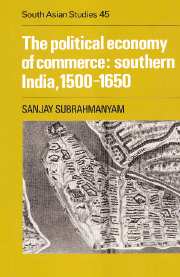Book contents
- Frontmatter
- Contents
- List of illustrations
- List of tables
- Preface
- Abbreviations used
- Introduction
- 1 The political economy of southern India, 1500–1650: preliminary remarks
- 2 Coastal trade and overland trade: complementarities and contradictions
- 3 Overseas trade, 1500–1570: traders, ports and networks
- 4 Overseas trade, 1570–1650: expansion and realignment
- 5 Europeans and Asians in an age of contained conflict
- 6 External commerce and political participation
- 7 Situating trade: models and methodological strategies
- Conclusion
- A note on currency and weights
- Glossary
- Note on sources
- Bibliography
- Index
- CAMBRIDGE SOUTH ASIAN STUDIES
3 - Overseas trade, 1500–1570: traders, ports and networks
Published online by Cambridge University Press: 13 January 2010
- Frontmatter
- Contents
- List of illustrations
- List of tables
- Preface
- Abbreviations used
- Introduction
- 1 The political economy of southern India, 1500–1650: preliminary remarks
- 2 Coastal trade and overland trade: complementarities and contradictions
- 3 Overseas trade, 1500–1570: traders, ports and networks
- 4 Overseas trade, 1570–1650: expansion and realignment
- 5 Europeans and Asians in an age of contained conflict
- 6 External commerce and political participation
- 7 Situating trade: models and methodological strategies
- Conclusion
- A note on currency and weights
- Glossary
- Note on sources
- Bibliography
- Index
- CAMBRIDGE SOUTH ASIAN STUDIES
Summary
Introduction
During the last two decades, our understanding of long-distance Indian Ocean commerce in the sixteenth century and the role of the Portuguese therein has come a long way from W.H. Moreland's notion that the Ocean was a Portuguese lake, in which ‘the absence of any serious opposition made it possible to control the seas by means of fleets of very moderate strength’. This idea went together, of course, with the idea of an ‘Iberian century’ in Indian history (or at least maritime history), broken only in the early seventeenth century with the arrival of the Dutch and the English Companies, who destroyed the stranglehold of the Portuguese over maritime commerce. Much of the debate, initiated by Moreland in the English-speaking world, and continued more recently in the works of M.N. Pearson and Niels Steensgaard, has tended to focus however on the western Indian Ocean, perhaps as a consequence of the concern with the relative importance of the Cape route and the overland route for the trade between Europe and Asia. It has been to a certain extent then, a debate with an implicitly Europocentric focus. If there is a secondary area of focus where Indian Ocean studies in the sixteenth century are concerned, it is the Indonesian archipelago, and the continued consideration of the effects of the capture of Melaka by the Portuguese in 1511, with the usual corollary being the study of the spice procurement in that region for the cargoes of Lisbon-bound Portuguese Indiamen.
- Type
- Chapter
- Information
- The Political Economy of Commerce: Southern India 1500–1650 , pp. 91 - 143Publisher: Cambridge University PressPrint publication year: 1990



